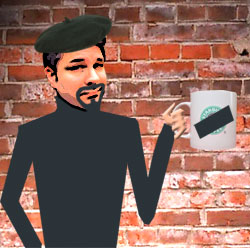Un-Branding Starbucks

Recently, Starbucks made news by announcing the opening of three coffee stores in Seattle that exhibit no corporate branding.
Referred to as “15th Ave. Coffee & Tea,” the new properties feature Starbucks coffee and teas as well as beer, wine, and ice cream, but are devoid of the familiar green-and-black logo. The look and feel of the stores is quite different from Starbucks’s usual interior design formula, and is being described as “European mercantile,” whatever that means.
The aim is to emulate the local coffee shop, complete with annoying music, inane poetry, and “social responsibility efforts” tailored to the locale of each store (perhaps like People for Uninformed Protesting).
I use the word “emulate” precisely because the concept is intrinsically non-genuine; Starbucks isn’t fooling anyone. But is that its purpose?
Starbucks is what it is: a predictable customer experience throughout the world. This is a major key to its success just as much as consistency was to the success of McDonald’s. Whether you are in Kapa’a, Kauai, Hawaii, or in Leicester Square, London, you can expect your strong Venti cup of coffee, or your Chai Tea Latte, with all the permutations of foam, heat, and probably isotopes of your favorite elements.
So why is one of the strongest brands in 20 years un-branding?
Starbucks is one of the most-used words in all of social media, appearing everywhere from Twitter to dating sites. The faux-beatnik treatment has already met with puzzlement and scorn. Why go underground? Is the company ashamed of what it is?
Over the years, Starbucks has gone to great lengths to operate responsibly. The company buys coffee from in-country co-ops that encourage better farming practices and create better prices for producers. It participates in local charities, despite what some pseudo-nouveau Marxist 20-somethings say. I like Starbucks; I’m writing this article from inside one right now.
When I lived in Long Beach, California, I used to frequent a wonderful coffee shop on Second Street called Polly’s. It’s laid-back, full of the robust aroma of house-roasted coffee, and it successfully beat back a full-frontal attack by Starbucks to put it out of business.
Starbucks located a store a block or so away, and one right across the street. The former is trafficked moderately, the latter is closed. Polly’s survived and thrived because of local support, which can only be generated through long-term quality and authenticity. It is what it is, and always has been.
Starbucks is not Polly’s. Nor should it be. Starbucks is trying to create a new brand that essentially un-brands their dominant brand.
And Starbucks is not alone. In an interview with NPR’s Scott Simon on Weekend Edition, AdWeek’s Barbara Lippert commented on Starbucks’s un-branding effort with this illustrative conversation:
Ms. LIPPERT: They don’t know whether they want to be the man or fight the man. You know, they fought all the way up there to get, you know, thousands of stores and billions of dollars in revenue, and now they want to undo that, and it’s the same thing with Holiday Inn.
They think that people, you know, won’t want to go to a Holiday Inn but they’ll want to go to some sort of, you know, masked separate entity that’s more boutique-y.
SCOTT SIMON: Well, I do wonder this, in league with you, because I – it does seem to be, you don’t, for example, check into a Holiday Inn looking for something quirky and charming but something reliable. And I don’t know how many times I’ve been somewhere in the globe where I absolutely welcome the reliability of an American or Western chain hotel, and for that matter a Starbucks, and unapologetically so.
Ms. LIPPERT: Exactly. And so why not just work on what they have? Just make it better. People like it enough but they can make their food better, they can make it more nutritious, they could get their prices down. The same thing with Holiday Inn. They could make them cleaner, they could make them more pleasant.
People like the brand names enough. They have huge equity in these brand names. I don’t know why they have to go into these little stealth categories.
SIMON: Are the Starbucks marketing people who are doing this – well, let me put it this way – and I am – I am a – I certainly am a Starbucks customer anywhere I go in the world – but do they think that people going into that coffee store are idiots?
Um. It’s certainly worth discussion over a cup of coffee. Got any place in mind?
Whether Starbucks is trying to establish another brand by stealthy means or not, the fact remains that it’s a mixed marketing message: You can’t be the man and be against the man.

 The future of digital experiences will be built by strategists who grasp the full array of emerging business, social, and technical models. Specialties in user experience, branding, application design, and data science are laying the foundation for richer user experiences and business models breakthrough products and revenue based marketing.
The future of digital experiences will be built by strategists who grasp the full array of emerging business, social, and technical models. Specialties in user experience, branding, application design, and data science are laying the foundation for richer user experiences and business models breakthrough products and revenue based marketing.